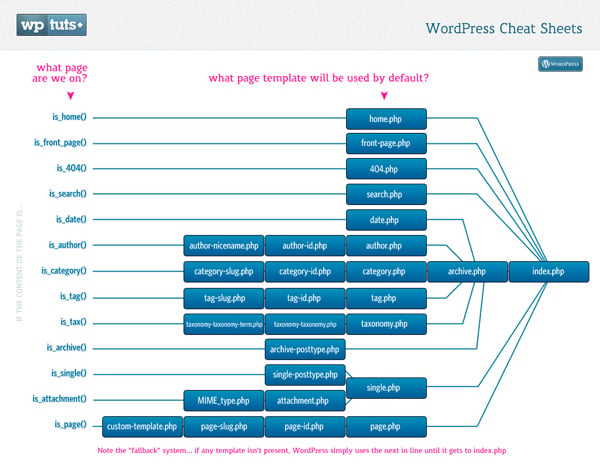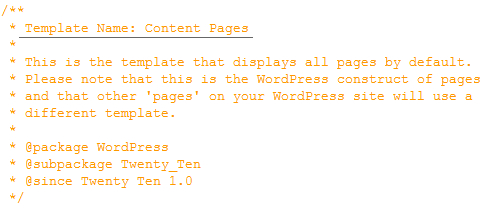
This article will show the WordPress theme file execution hierarchy. In a nutshell, we’ll look at what files are served when you load a page in WordPress. You probably already know that detail posts are served by single.php and detail pages are served by page.php, but WordPress searches different files based on various factors, so we’ll take a look at how that works! p>
The first thing we should determine is: without index.php and style.css, your theme is no longer a valid WordPress theme... So this is It stands to reason that if you only have these two files, then every page you try to load will be served by index.php. Take a quick look at this "cheat sheet" to see what I'm referring to:

Please note that the process for each page type will end with index.php. This is why index.php is a required file for WordPress themes. If we are missing any other file in the WordPress theme (for example, if the “search.php” file is not included in the theme), then index.php will be provided.
Now let's look at some details about the order of execution. I’m going to show you the process of WordPress searching for files in the active theme folder. I hope this is useful as you start creating WordPress themes from now on:
I will go through each type of file one by one and show the execution hierarchy of the same files.
This is the first and most important page of any website. So WordPress provides scope for customizing pages. Let’s take a look at the file hierarchy for the home page.
When serving a homepage, WordPress will search for front-page.php. If not found, it will use home.php. If home.php exists, it will use it. If not, it will default to index.php.
WordPress can have as many post types as we need. So it will be easier to get different designs for all/certain post types. By default, "post" is WordPress's primary and default post type.
For example, if your custom post type is product, then it will be single-product.php
To know more about how to add a new post type in WordPress, you can refer to this link.

Like post types, we can have different page layouts using custom page templates. So WordPress first searches for the file of the selected page template if it exists.
If not found, the file of the current page slug will be searched. Basically, if the slug is aboutus, then it will search for the file page-aboutus.php in the active theme folder.
WordPress will search for files with IDs just like files with slugs.
From the above process, you can understand how to use different templates for category pages. For example, you could have a custom page based on slug and id, and then use the default "category.php" file for the rest of the categories.
This will be the same as category. You can also set up different pages for tag slug and tag id.
Here are the different file hierarchies for category pages.
Here you will know that you can also have different designs based on the user. Same with categories and tags, we can have different files based on the user's slug and ID.
Here you can see that different types of attachments can have different page layouts. These can be distinguished from the MIME type of the attached file.
For date specific layout, we can create date.php in the theme folder. The process then goes to archive.php and finally to index.php.
As we move down through the file types, the number of files in the hierarchy decreases. This is the basic file or we can say the most commonly used file in any WordPress theme.
You can use search.php to customize search results first. If search.php is not available, index.php will be served.
If the page or post is not found, WordPress will search for 404.php and if not found, it will serve index.php.
Obviously you can use this information in a number of ways to load custom templates for various pages... In many cases you can get a custom solution without modifications, even if you use an existing theme Existing theme files. You just need to create the new file and give it a new name using the information above.
Share your ideas and any other files that can be included above the hierarchy.
The above is the detailed content of Execution Hierarchy of WordPress Theme Files. For more information, please follow other related articles on the PHP Chinese website!
 How to solve http request 415 error
How to solve http request 415 error
 What is the difference between webstorm and idea?
What is the difference between webstorm and idea?
 What are the video server configuration parameters?
What are the video server configuration parameters?
 Is OuYi Exchange legal?
Is OuYi Exchange legal?
 How to adjust computer screen brightness
How to adjust computer screen brightness
 What should I do if my computer starts up and the screen shows a black screen with no signal?
What should I do if my computer starts up and the screen shows a black screen with no signal?
 How to open ESP files
How to open ESP files
 ps serial number cs5
ps serial number cs5




